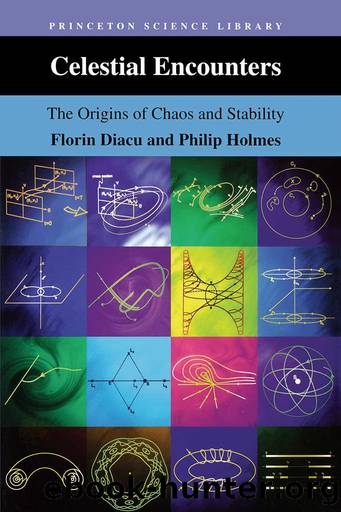Celestial Encounters: 22 (Princeton Science Library, 119) by Florin Diacu & Philip J. Holmes

Author:Florin Diacu & Philip J. Holmes
Language: eng
Format: azw3
Publisher: Princeton University Press
Published: 2020-12-07T23:00:00+00:00
Figure 3.13. Xiaâs example of a noncollision singularity.
Simple though this scenario sounds, it is difficult to carry through for Newtonian gravitational laws. Since the motion is to become unbounded in finite time, the acceleration of the small particle must grow infinitely large. To produce the requisite slingshot effect, the point masses in each binary must approach closer and closer, making it hard to guarantee that binary collisions do not occur. Here the structure of stable and unstable manifolds of the collision points is used in a subtle way to eliminate âbadâ sets of solutions at each stage. Those which lead to collisions on the next encounter or for which m5 arrives at the wrong time are removed from the set of candidate solutions. In addition to âaimingâ m5 correctly, the angular velocities of the binaries have to be reduced a little at each step, so that the encounters can become close enough. All this requires a most delicate touch. After repeating the process for infinitely many encounters, one is left with a Cantor set of initial conditions that lead to solutions behaving as we have described.
How can one remove infinitely many unsuitable sets and still be left with something? Xia had to show that, at each step, a finite patch of solutions survives. The reader will recall that we used a similar, but simpler, construction in chapter 2 while building the Cantor set of points which never escape from Smaleâs horseshoe (fig. 2.6). We also described the construction of the middle-third Cantor set earlier in this chapter (fig. 3.7). Xia used a similar construction in this much more complicated case. In fact, Cantor sets are rife in this subject: in the collinear example of Mather and McGehee described earlier, there is also a Cantor set of initial conditions with the desired behavior.
In this way Jeff Xia showed that there are initial data such that collisions can be avoided and the binaries driven to infinity in finite time. He revealed a rare capacity to overcome, on the one hand, technical difficulties, and to manipulate, on the other, a vast quantity of mathematics. He introduced a number of new ideas, but above all, his proof is a wonderful example of collective scientific effort. He brought to bear everything he knew about the n-body problem, using a host of results and techniques developed by others before him. It took almost a century to assemble the edifice that supports this lovely conclusion. Xiaâs theorem is at the apex, but, without the stones laid by his predecessors, there would be no building.
In the summer of 1993, a joint meeting of the Canadian and American Mathematical Societies was held at the University of British Columbia in Vancouver. The occasion was used to present the first Blumenthal Award, to be made every four years in recognition of distinguished achievements in mathematics. The selection committee included Vaughan Jones from Berkeley (himself a Fields medalist in 1990), Robert Langlands from the Institute for Advanced Study in Princeton and the
Download
This site does not store any files on its server. We only index and link to content provided by other sites. Please contact the content providers to delete copyright contents if any and email us, we'll remove relevant links or contents immediately.
| Aeronautics & Astronautics | Astronomy |
| Astrophysics & Space Science | Comets, Meteors & Asteroids |
| Cosmology | Mars |
| Solar System | Star-Gazing |
| Telescopes | UFOs |
Turbulence by E. J. Noyes(7058)
Tools of Titans by Timothy Ferriss(6965)
Astrophysics for People in a Hurry by Neil DeGrasse Tyson(4628)
Room 212 by Kate Stewart(4116)
Pale Blue Dot by Carl Sagan(4017)
The David Icke Guide to the Global Conspiracy (and how to end it) by David Icke(3892)
Secrets of Antigravity Propulsion: Tesla, UFOs, and Classified Aerospace Technology by Ph.D. Paul A. Laviolette(3567)
Apollo 8 by Jeffrey Kluger(3205)
Losing the Nobel Prize by Brian Keating(3188)
A Journey Through Divination and Astronomy by Publishing Pottermore(3154)
Goodbye Paradise(2977)
COSMOS by Carl Sagan(2959)
Brief Answers to the Big Questions by Stephen Hawking(2883)
How to Read Water: Clues and Patterns from Puddles to the Sea (Natural Navigation) by Tristan Gooley(2875)
The Five People You Meet in Heaven by Mitch Albom(2850)
The Order of Time by Carlo Rovelli(2728)
How to Read Nature by Tristan Gooley(2668)
A Brief History of Time by Stephen Hawking(2480)
Aliens by Jim Al-Khalili(2387)
